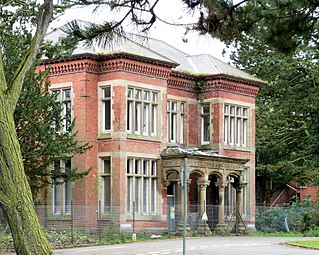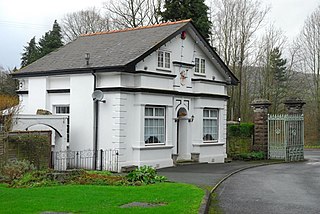
The Countess of Chester Hospital is the main NHS hospital for the English city of Chester and the surrounding area. It currently has 625 beds, general medical departments and a 24-hour accident and emergency unit. It is managed by the Countess of Chester Hospital NHS Foundation Trust, one of the first Foundation Trusts in the UK, formed in 2004. Cardiac rehabilitation services at the hospital are provided by Cheshire and Wirral Partnership NHS Foundation Trust.

Claybury Hospital was a psychiatric hospital in Woodford Bridge, London. It was built to a design by the English architect George Thomas Hine who was a prolific Victorian architect of hospital buildings. It was opened in 1893 making it the Fifth Middlesex County Asylum. Historic England identified the hospital as being "the most important asylum built in England after 1875".

The Callan Park Hospital for the Insane (1878–1914) is a heritage-listed former insane asylum, which was subsequently, for a time, used as a college campus, located in the grounds of Callan Park, an area on the shores of Iron Cove in Lilyfield, a suburb of Sydney, New South Wales, Australia. In 1915, the facility was renamed as the Callan Park Mental Hospital and, again in 1976, to Callan Park Hospital. Since 1994, the facility has been formally known as Rozelle Hospital. In April 2008, all Rozelle Hospital services and patients were transferred to Concord Hospital. The Callan Park Act, 2002 (NSW) restricts future uses of the site to health, tertiary education and community uses.

Whitchurch Hospital was a psychiatric hospital in Whitchurch, an area in the north of Cardiff. It was managed by the Cardiff and Vale University Health Board. The hospital remains a grade II listed building. Its grounds are separately listed, also at Grade II, on the Cadw/ICOMOS Register of Parks and Gardens of Special Historic Interest in Wales.

Whittingham Hospital was a psychiatric hospital in the parish of Whittingham, near Preston, Lancashire, England. The hospital opened in 1873 as the Fourth Lancashire County Asylum and grew to be the largest mental hospital in Britain, and pioneered the use of electroencephalograms (EEGs). It closed in 1995.

The North Wales Hospital is a Grade II* listed building in Denbigh, Denbighshire, Wales. Designed by architect Thomas Fulljames, building started in 1844 and completed in 1848. Initially a hospital for up to 200 people with psychiatric illness, by the mid-20th century it housed 1,500 patients. The institution was wound down as a healthcare facility from 1991, finally closing in 1995. There was much damage caused to the structure and its contents in the years subsequent to closure. The site was compulsorily purchased by Denbighshire Council in 2018 and plans were announced late that year for its redevelopment as housing.

West Park Hospital was a large psychiatric hospital in Epsom, Surrey.

Bronllys Hospital is a heath facility in Bronllys, Wales. It is managed by Powys Teaching Health Board. The Basil Webb Hall and the Chapel are Grade II listed buildings. The hospital grounds are listed Grade II on the Cadw/ICOMOS Register of Parks and Gardens of Special Historic Interest in Wales.

Springfield University Hospital is a psychiatric hospital in Tooting, South London and also the headquarters of the South West London and St George's Mental Health NHS Trust.

St Augustine's Hospital was a psychiatric hospital in Chartham, Kent, England. It was founded as the second, or East, Kent County Asylum in 1872. In 1948 the hospital became part of the National Health Service and was renamed St Augustine's Hospital. The hospital gained notoriety in the 1970s when it was the subject of a committee of inquiry into malpractice and mismanagement. St Augustine's Hospital closed in 1993 and the site is now occupied by housing, although a few of the original hospital buildings remain.

Horton Hospital, formerly called Horton Asylum, was a large psychiatric hospital in the Horton area of Epsom, Surrey.

The Manor Hospital, formerly The Manor Asylum and The Manor Certified Institution was a mental handicap and psychiatric hospital in Horton, near Epsom, Surrey, United Kingdom

Netherne Hospital, formerly The Surrey County Asylum at Netherne or Netherne Asylum was a psychiatric hospital in Hooley, Surrey in the United Kingdom.

Maindiff Court Hospital is a community hospital near Abergavenny, Monmouthshire. It is managed by the Aneurin Bevan University Health Board. Its most noted patient was Rudolf Hess, deputy to Adolf Hitler.

Graylingwell Hospital was a psychiatric hospital in Chichester, West Sussex, United Kingdom.

Roundway Hospital was a psychiatric hospital in the parish of Roundway near Devizes, Wiltshire, England. It was originally called the Wiltshire County Lunatic Asylum and later the Wiltshire County Mental Hospital. It opened in 1851 and closed in 1995.

The Old Manor Hospital was a psychiatric hospital in Salisbury, Wiltshire, England. It was established in the early 19th century as a private licensed house called Fisherton House or Fisherton House Asylum, which became the largest private madhouse in the United Kingdom. In 1924, following a change of proprietors, it was renamed Old Manor Hospital and in 1955 it was amalgamated into the National Health Service. From 1813 to 1955 it was owned and managed by members of the same family. The Old Manor Hospital closed in 2003 and was replaced by Fountain Way, a smaller, modern, psychiatric hospital on part of the same site. In 2014 the site was acquired by Quantum Group for development as a residential estate and the conversion of the main building to a hotel.

Powys Teaching Health Board (PTHB) is the local health board of NHS Wales for Powys in Mid Wales. PTHB is responsible for healthcare in Powys, covering the same area as Powys County Council. It was established in 2003. Its headquarters are at Bronllys Hospital near Talgarth, Powys, Wales. Powys Teaching Health Board is the operational name of Powys Local Health Board.

St David's Hospital was a psychiatric hospital in Carmarthen, Wales. The main Victorian building is Grade II listed.

Cherry Knowle Hospital was a mental health facility in Ryhope, Tyne and Wear, England. It was managed by the South of Tyne and Wearside Mental Health NHS Trust.





















